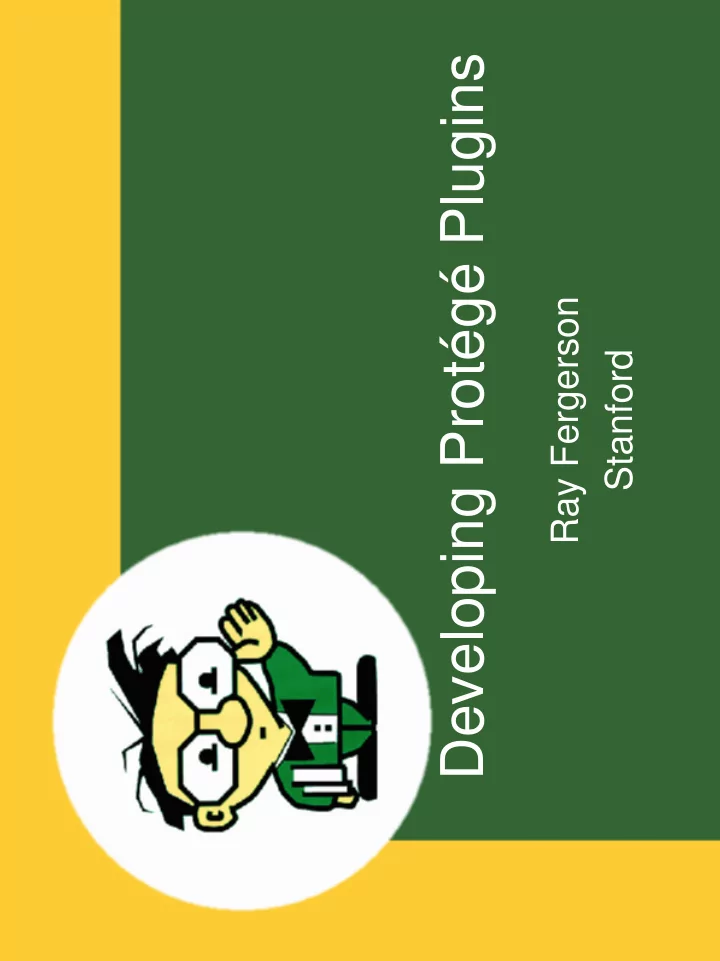

Developing Protégé Plugins Ray Fergerson Stanford
Overview • What is a Plugin? • How Plugins work • Plugin Types and Capabilities • Development Tips • Packaging • Bundling • Coming Changes
Out of Scope • Standard Java – Coding – Packaging (jars) – Utilities • Development environments • Licensing (see FAQ) • Non-plugin extensions
What is a Plugin? • Extension to Protege – Requires no source code modifications – Loaded and managed by system • Typically the implementation of a Java interface and an entry in a Java manifest file. • Typically packaged as one or more jar files and installed in a subdirectory of the Protege plugins directory
How Plugins work • System looks at all manifests available: – On the classpath – In directories one level down from plugins • all jars • File meta-inf/manifest.mf • System looks for a manifest entry identifying a plugin and loads the referenced class • System creates an instance of the class as needed
Types of Plugins • TabWidget • SlotWidget • KnowledgeBaseFactory (“Backend”) • ProjectPlugin • ExportPlugin • ImportPlugin
Plugin: TabWidget • What is it? – Large piece of screen real-estate – Can interact with domain KB browse, change, delete, corrupt • What are its limitations? – Difficult to supplement or even interact with other tabs • How hard is it to create? – Easy (1 day)
TabWidget Example (for all example code see http://protege.stanford.edu/doc/pdk)
Plugin: SlotWidget • What is it? – UI Control which allows the user to display and modify a slot value – Follows a protocol for hiding interaction KB • What are its limitations? – Works best with a single slot • How hard is it to create? – Easy (1 day)
SlotWidget Example (for all example code see http://protege.stanford.edu/doc/pdk)
Plugin: KnowledgeBaseFactory • What is it? – Replacement for the standard storage mechanisms with • Database • External server • … – Allows for parsing of different file formats • What are its limitations? – Difficult to manipulate UI – Implementations tend to be buggy • How hard is it to create? – Hard (>= 1 month) – Consider Import/Export plugin instead
KnowledgeBaseFactory Example (for all example code see http://protege.stanford.edu/doc/pdk)
Plugin: ProjectPlugin • What is it? – Code that executes when “things happen” to a project (create, load, display, close, etc) – Get access to project, view, menu bar, tool bar and can modify them as you like • How hard is it to create? – Easy (1 day)
ProjectPlugin Example (for all example code see http://protege.stanford.edu/doc/pdk)
Plugin: ExportPlugin • What is it? – Code that saves (part of) a knowledge-base in any given format to somewhere else • files, servers, web, … – No change of the current backend – No guarantee of “round trip” (export->import) – No “live” connection • How hard is it to create? – Medium (1 week)
ExportPlugin Example (for all example code see http://protege.stanford.edu/doc/pdk)
Plugin: ImportPlugin • What is it? – Code that creates a knowledge-base from information from somewhere else • files, servers, web, … – No change of the current backend – No guarantee of “round trip” (export->import) – No “live” connection • How hard is it to create? – Medium (1 week)
ImportPlugin Example (for all example code see http://protege.stanford.edu/doc/pdk)
Development Tips • To ease integration with a debugger – implement a main() method • To avoid making a jar while debugging – Put your meta-inf/manifest.mf file on the classpath • To access icons from your code: – use FileUtilities.loadImageIcon() • Access the plugin’s directory for config files – PluginUtilites.getInstallationDirectory() • Watch out for caching!
Packaging • Create a directory structure like: edu.stanford.smi.protegex.myproject/ myproject.jar myproject_doc.html myproject_about.html plugin.properties • Zip it up
Packaging II • Sample Plugin properties file plugin.component.count=1 plugin.component.name.0=PROMPT tab plugin.component.about.0=about_prompt.html plugin.component.doc.0=doc/index.html plugin.dependency.count=1 plugin.dependency.0=edu.stanford.smi.protegex.owl
Bundling • Plugins can be “bundled” with the full release and made available to all users • Advantage: – You may get a lot of users quickly • Disadvantage: – You may get a lot of users quickly • In order to be bundled the plugin must be: – Well Formed – Well Behaved – Well Maintained
Bundling II • Well Formed – jar file in an appropriate, recognizable directory • appropriate: “edu.myschool.mygroup.myproject”, not “foo” • recognizable: last directory element: “mytab” not “foo” – About Box and Documentation entries – Minimal size • minimal documentation – links to more extensive documentation on web – no PDF, MS Word, large image files • no source • at most one small example project • readme.txt file if necessary – isSuitable implemented if appropriate • requires certain sorts of projects or additional installation (shared libraries, etc)
Bundling III • Well Behaved – Must “work” (not crash on startup) with the current release – Minimal information (just errors) printed to the console window • Single startup line is ok (but certainly not required) • No tracing – Must start up and shut down smoothly • No time consuming code executed in static initializer • No long start up delays or modal dialogs that block the rest of the system • Must free acquired resources in “dispose()” • Well Maintained – Developer/maintainer “responsive” to problems.
Coming Changes • Nothing major! • Additional fixes to class loader mechanism • Allow users to disable installed plugins • Additional optional “static interface” methods: – isSuitable() for other plugin types – buildString() for macro substitution on About Box page • Optional localization support for plugins • Documented procedures for bundling
Summary Plugins provide flexible and powerful mechanisms for extending Protege in many ways. Go do something interesting! (Think about contributing it back to the community.)
Recommend
More recommend